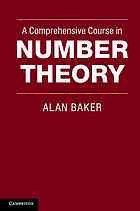Table Of ContentA Comprehensive Course in B
A
k
Number Theory e A Comprehensive Course in
r
A Number
K Developed from the author’s popular text, A Concise Introduction to the Theory
L C
b of Numbers, this book provides a comprehensive initiation to all the major o
branches of number theory. Beginning with the rudiments of the subject, the m
y
aauntdh porri mpraolciteye tdess ttiong m; aonre a acdcvoaunncte odf ntoupmicbse, ri nficelluddsi ning t ehlee mclaesnstsic oafl cveryinp tiongclruadpihnyg pre
m h
pthreoopreyr tiinecsl uodf itnhge isr tuundiitess, iodfe tahles Raniedm idaenanl zcelatas-sfeusn;c atsiopne,c tthse o pf raimnael-yntiucm nbuemr ber en Theory
C s
theorem and primes in arithmetical progressions; a description of the Hardy– ive
r Littlewood and sieve methods from, respectively, additive and multiplicative
e C
number theory; and an exposition of the arithmetic of elliptic curves.
V o
o The book includes many worked examples, exercises and, as with the u
C r
earlier volume, there is a guide to further reading at the end of each chapter. s
y e
r Its wide coverage and versatility make this book suitable for courses extending
i
o from the elementary to the graduate level. n
e N Al An BAker
h
T u
r m
e Alan Baker, FRS, is Emeritus Professor of Pure Mathematics in the University
b b
of Cambridge and Fellow of Trinity College, Cambridge. His many distinctions
m
e
include the Fields Medal (1970) and the Adams Prize (1972).
u
r
N
n T
i
e
s h
r
u e
o
C
o
e
v
si r
n
e y
h
e
r
p
m
o
C
A
:
r
e
k
A
B
Cover designed by Hart McLeod Ltd
AComprehensiveCourseinNumberTheory
Developedfromtheauthor’spopulartext,AConciseIntroductiontotheTheoryof
Numbers,thisbookprovidesacomprehensiveinitiationtoallthemajorbranchesof
numbertheory.Beginningwiththerudimentsofthesubject,theauthorproceedsto
moreadvancedtopics,includingelementsofcryptographyandprimalitytesting;an
accountofnumberfieldsintheclassicalveinincludingpropertiesoftheirunits,ideals
andidealclasses;aspectsofanalyticnumbertheoryincludingstudiesoftheRiemann
zeta-function,theprime-numbertheoremandprimesinarithmeticalprogressions;a
descriptionoftheHardy–Littlewoodandsievemethodsfrom,respectively,additive
andmultiplicativenumbertheory;andanexpositionofthearithmeticofelliptic
curves.
Thebookincludesmanyworkedexamples,exercisesand,aswiththeearlier
volume,thereisaguidetofurtherreadingattheendofeachchapter.Itswidecoverage
andversatilitymakethisbooksuitableforcoursesextendingfromtheelementaryto
thegraduatelevel.
AlanBaker,FRS,isEmeritusProfessorofPureMathematicsintheUniversityof
CambridgeandFellowofTrinityCollege,Cambridge.Hismanydistinctionsinclude
theFieldsMedal(1970)andtheAdamsPrize(1972).
A COMPREHENSIVE COURSE
IN NUMBER THEORY
ALAN BAKER
UniversityofCambridge
cambridge university press
Cambridge,NewYork,Melbourne,Madrid,CapeTown,
Singapore,SãoPaulo,Delhi,MexicoCity
CambridgeUniversityPress
TheEdinburghBuilding,CambridgeCB28RU,UK
PublishedintheUnitedStatesofAmericabyCambridgeUniversityPress,NewYork
www.cambridge.org
Informationonthistitle:www.cambridge.org/9781107019010
(cid:2)c CambridgeUniversityPress2012
Thispublicationisincopyright.Subjecttostatutoryexception
andtotheprovisionsofrelevantcollectivelicensingagreements,
noreproductionofanypartmaytakeplacewithoutthewritten
permissionofCambridgeUniversityPress.
Firstpublished2012
PrintedandiboundiintheUnitedKingdombyitheMPGiBooksiGroup
AcataloguerecordforthispublicationisavailablefromtheBritishLibrary
LibraryofCongressCataloguinginPublicationdata
Baker,Alan,1939–
Acomprehensivecourseinnumbertheory/AlanBaker.
p. cm.
Includesbibliographicalreferencesandindex.
ISBN978-1-107-01901-0(hardback)
1. Numbertheory–Textbooks. I. Title.
QA241.B237 2012
512.7–dc23
2012013414
ISBN978-1-107-01901-0Hardback
ISBN978-1-107-60379-0Paperback
CambridgeUniversityPresshasnoresponsibilityforthepersistenceor
accuracyofURLsforexternalorthird-partyinternetwebsitesreferredto
inthispublication,anddoesnotguaranteethatanycontentonsuch
websitesis,orwillremain,accurateorappropriate.
Contents
Preface pagexi
Introduction xiii
1 Divisibility 1
1.1 Foundations 1
1.2 Divisionalgorithm 1
1.3 Greatestcommondivisor 2
1.4 Euclid’salgorithm 2
1.5 Fundamentaltheorem 4
1.6 Propertiesoftheprimes 4
1.7 Furtherreading 6
1.8 Exercises 7
2 Arithmeticalfunctions 8
2.1 Thefunction[x] 8
2.2 Multiplicativefunctions 9
2.3 Euler’s(totient)functionφ(n) 9
2.4 TheMöbiusfunctionμ(n) 10
2.5 Thefunctionsτ(n)andσ(n) 12
2.6 Averageorders 13
2.7 Perfectnumbers 14
2.8 TheRiemannzeta-function 15
2.9 Furtherreading 17
2.10 Exercises 17
3 Congruences 19
3.1 Definitions 19
3.2 Chineseremaindertheorem 19
3.3 ThetheoremsofFermatandEuler 21
3.4 Wilson’stheorem 21
v
vi Contents
3.5 Lagrange’stheorem 22
3.6 Primitiveroots 23
3.7 Indices 26
3.8 Furtherreading 26
3.9 Exercises 26
4 Quadraticresidues 28
4.1 Legendre’ssymbol 28
4.2 Euler’scriterion 28
4.3 Gauss’lemma 29
4.4 Lawofquadraticreciprocity 30
4.5 Jacobi’ssymbol 32
4.6 Furtherreading 33
4.7 Exercises 34
5 Quadraticforms 36
5.1 Equivalence 36
5.2 Reduction 37
5.3 Representationsbybinaryforms 38
5.4 Sumsoftwosquares 39
5.5 Sumsoffoursquares 40
5.6 Furtherreading 41
5.7 Exercises 42
6 Diophantineapproximation 43
6.1 Dirichlet’stheorem 43
6.2 Continuedfractions 44
6.3 Rationalapproximations 46
6.4 Quadraticirrationals 48
6.5 Liouville’stheorem 51
6.6 Transcendentalnumbers 53
6.7 Minkowski’stheorem 55
6.8 Furtherreading 58
6.9 Exercises 59
7 Quadraticfields 61
7.1 Algebraicnumberfields 61
7.2 Thequadraticfield 62
7.3 Units 63
7.4 Primesandfactorization 65
Contents vii
7.5 Euclideanfields 66
7.6 TheGaussianfield 68
7.7 Furtherreading 69
7.8 Exercises 70
8 Diophantineequations 71
8.1 ThePellequation 71
8.2 TheThueequation 74
8.3 TheMordellequation 76
8.4 TheFermatequation 80
8.5 TheCatalanequation 83
8.6 Theabc-conjecture 85
8.7 Furtherreading 87
8.8 Exercises 88
9 Factorizationandprimalitytesting 90
9.1 Fermatpseudoprimes 90
9.2 Eulerpseudoprimes 91
9.3 Fermatfactorization 93
9.4 Fermatbases 93
9.5 Thecontinued-fractionmethod 94
9.6 Pollard’smethod 96
9.7 Cryptography 97
9.8 Furtherreading 97
9.9 Exercises 98
10 Numberfields 99
10.1 Introduction 99
10.2 Algebraicnumbers 100
10.3 Algebraicnumberfields 100
10.4 Dimensiontheorem 101
10.5 Normandtrace 102
10.6 Algebraicintegers 103
10.7 Basisanddiscriminant 104
10.8 Calculationofbases 106
10.9 Furtherreading 109
10.10 Exercises 109
11 Ideals 111
11.1 Origins 111
viii Contents
11.2 Definitions 111
11.3 Principalideals 112
11.4 Primeideals 113
11.5 Normofanideal 114
11.6 Formulaforthenorm 115
11.7 Thedifferent 117
11.8 Furtherreading 120
11.9 Exercises 120
12 Unitsandidealclasses 122
12.1 Units 122
12.2 Dirichlet’sunittheorem 123
12.3 Idealclasses 126
12.4 Minkowski’sconstant 128
12.5 Dedekind’stheorem 129
12.6 Thecyclotomicfield 131
12.7 Calculationofclassnumbers 136
12.8 Localfields 139
12.9 Furtherreading 144
12.10 Exercises 145
13 Analyticnumbertheory 147
13.1 Introduction 147
13.2 Dirichletseries 148
13.3 Tchebychev’sestimates 151
13.4 Partialsummationformula 153
13.5 Mertens’results 154
13.6 TheTchebychevfunctions 156
13.7 Theirrationalityofζ(3) 157
13.8 Furtherreading 159
13.9 Exercises 160
14 Onthezerosofthezeta-function 162
14.1 Introduction 162
14.2 Thefunctionalequation 163
14.3 TheEulerproduct 166
14.4 Onthelogarithmicderivativeofζ(s) 167
14.5 TheRiemannhypothesis 170
14.6 Explicitformulaforζ(cid:3)(s)/ζ(s) 171
14.7 Oncertainsums 173
Contents ix
14.8 TheRiemann–vonMangoldtformula 174
14.9 Furtherreading 177
14.10 Exercises 177
15 Onthedistributionoftheprimes 179
15.1 Theprime-numbertheorem 179
15.2 Refinementsanddevelopments 182
15.3 Dirichletcharacters 184
15.4 Dirichlet L-functions 186
15.5 Primesinarithmeticalprogressions 187
15.6 Theclassnumberformulae 189
15.7 Siegel’stheorem 191
15.8 Furtherreading 194
15.9 Exercises 194
16 Thesieveandcirclemethods 197
16.1 TheEratosthenessieve 197
16.2 TheSelbergupper-boundsieve 198
16.3 ApplicationsoftheSelbergsieve 202
16.4 Thelargesieve 204
16.5 Thecirclemethod 207
16.6 Additiveprimenumbertheory 210
16.7 Furtherreading 213
16.8 Exercises 214
17 Ellipticcurves 215
17.1 Introduction 215
17.2 TheWeierstrass℘-function 216
17.3 TheMordell–Weilgroup 220
17.4 Heightsonellipticcurves 222
17.5 TheMordell–Weiltheorem 225
17.6 Computingthetorsionsubgroup 228
17.7 Conjecturesontherank 230
17.8 Isogeniesandendomorphisms 232
17.9 Furtherreading 237
17.10 Exercises 238
Bibliography 240
Index 246

